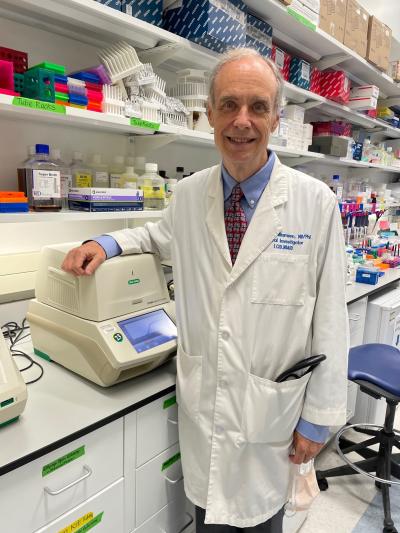
Peter Williamson, M.D., Ph.D.
How would you summarize what you currently do at NIAID?
We currently bring in very sick patients from all over the United States who develop meningitis with the fungus Cryptococcus but have no underlying reason to get these infections. Currently, these infections are the most common cause of non-viral meningitis in the United States but there is little understanding on how to treat patients or why individuals get these infections. Currently, up to a third die with current therapies. We do genetic and immunological studies and the NIH Clinical Center is a fantastic place that allows superior patient care and sophisticated scientific studies that can guide new treatments. This has allowed us to identify an unrecognized inflammatory syndrome in these patients and provide science-based treatments that reverse the disease and return patients to their previous lives.
What does a typical day at work look like for you?
Our team first sees any patients we may have in the NIH Clinical Center, often with residents, physicians, and infectious disease fellows both in our NIH training program as well as hospitals within the Washington area. I then review research on our patients performed by our laboratory of scientists, post-doctorates and visiting fellows that could involve review of the latest genetic or immunological results or the development and study of our many mouse models. The mouse studies are critical to replicate and dissect the novel immune deficiencies we have identified in our patients in order to develop targeted therapies. Much of our science involves extramural collaborators around the world, which utilizes the unique expertise within the extramural community. Writing scientific papers takes a lot of my time, which is an important method of communicating our new results.
How long have you been at NIAID and what was your career path to arrive here?
I received my M.D./Ph.D. from Boston University in 1987 and completed a residency in internal medicine at Georgetown University before coming to the National Institutes of Health for a fellowship in infectious diseases. In 1995, after serving a short stint as chief medical officer, Lalmba Sudan, I joined the faculty at the University of Illinois at Chicago as an assistant professor of medicine in the section of infectious diseases. After progressing to the rank of professor of medicine, pathology, microbiology, and immunology, I then returned to NIH 13 year ago to head the Translational Mycology Unit in the Laboratory of Clinical Infectious Diseases, which is now the Translational Mycology Section in the Laboratory of Clinical Immunology & Microbiology.
Are there any special or unique projects that you are working on?
We are currently working on developing an international multi-center clinical trial on the use of immunomodulatory therapy for high-risk patients with cryptococcal meningitis, based on clinical/translational data generated at the NIH Clinical Center.
What do you like about working at NIAID?
Very collaborative and open to new ideas. Very supportive of a strong clinical program and integrating basic and translational science into personalized clinical treatments.
What are your future career goals?
One of the distinct privileges here at intramural NIH is a very reliable funding stream that allows the rapid development of cutting-edge science that can change patient care. Finding and advancing new paradigms to improve outcomes in patients with fungal infections will continue to drive our work.
Do you have any advice to offer others who might be considering working at NIAID?
A great place to work if you want to work hard on great science and have fun doing it.
Reference to Relevant Program Content
NIAID Infectious Diseases Fellowship Program
NIH Academy on Health Disparities
NIH Community College Summer Enrichment Program (CCSEP)
NIH African Postdoctoral Training Initiative (APTI)


